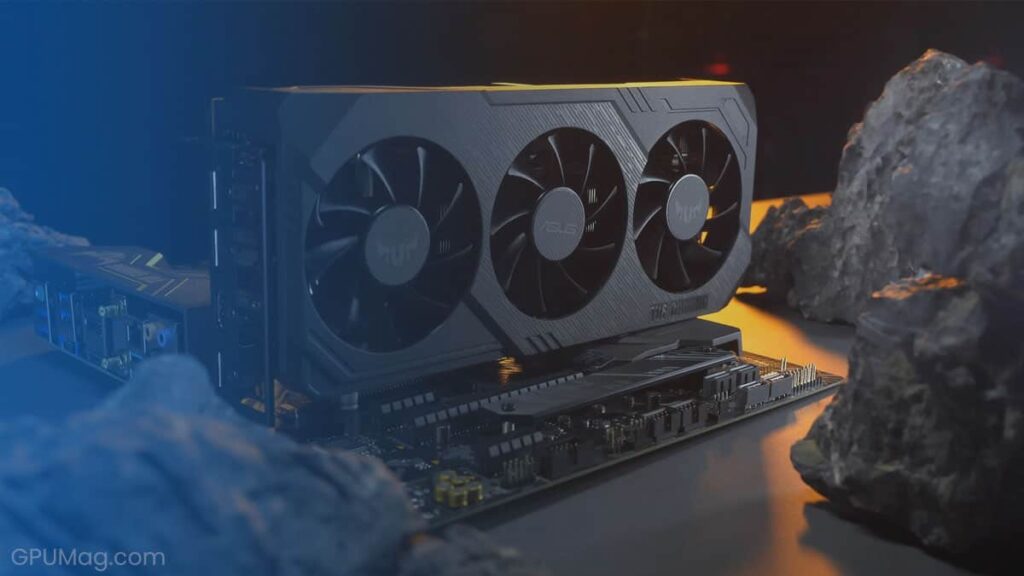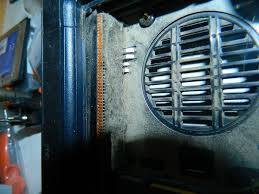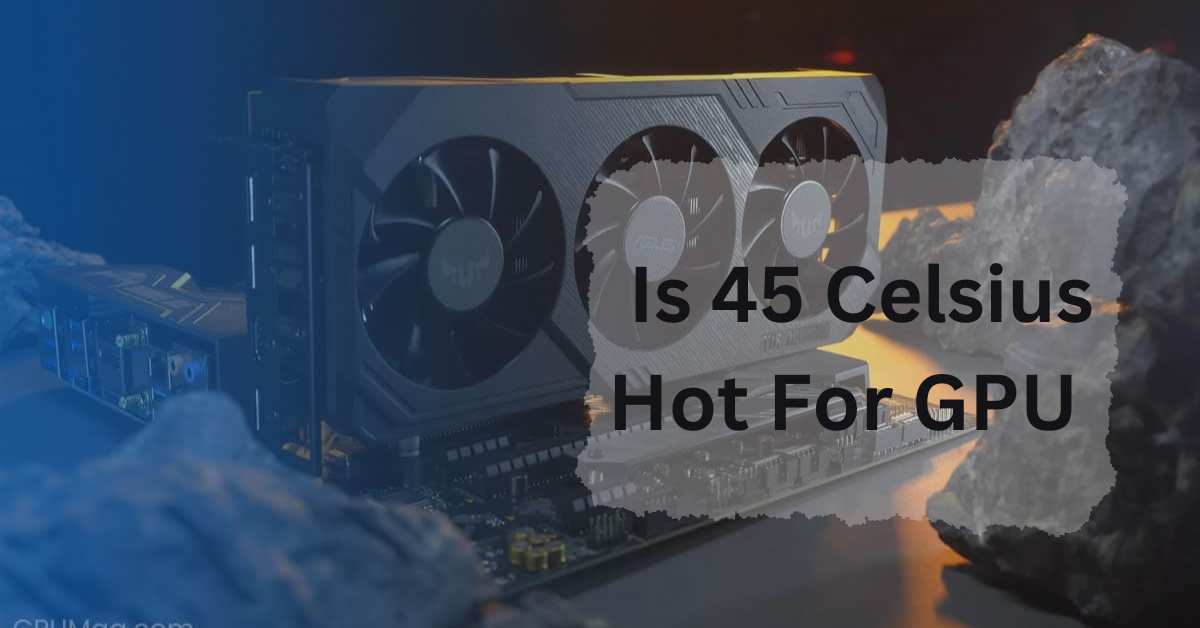Your GPU (Graphics Processing Unit) is a critical component in your computer, especially if you’re into gaming, video editing, or any graphics-intensive tasks. One of the most crucial aspects of maintaining your GPU is keeping an eye on its temperature. But what exactly is considered a safe temperature for your GPU?
Yes, 45°C is cool for a GPU. GPUs can safely run at temperatures up to 85°C or higher. At 45°C, your GPU is operating well within safe limits, ensuring good performance and long life.
In this article, we will discuss “Is 45 Celsius Hot For GPU”.
Table of Contents
Understanding GPU Temperature:
What is GPU Temperature?
GPU temperature refers to the heat produced by the graphics card during its operation. This temperature can vary depending on the workload, the ambient temperature, and the efficiency of the cooling system.
How is GPU Temperature Measured?
GPU temperature is typically measured using built-in sensors in the GPU. These sensors relay data to software that can display the temperature in real time, allowing users to monitor and manage it effectively.
Optimal GPU Temperature Range:
1. Safe Operating Temperatures:
Most GPUs are designed to operate safely within a temperature range of 60 to 85 degrees Celsius under load. During idle or less intensive tasks, temperatures can be much lower, often ranging from 30 to 50 degrees Celsius.
2. Manufacturer Guidelines:
GPU manufacturers provide specific temperature guidelines for their products. It’s always a good idea to check these guidelines to ensure your GPU is running within safe limits.
Factors Affecting GPU Temperature:

1. Workload and Usage:
High-intensity tasks such as gaming or video rendering can cause your GPU to heat up significantly. Conversely, lighter tasks like web browsing or office work will keep the GPU cooler.
2. Ambient Temperature:
The temperature of the environment where your computer is located plays a significant role. A cooler room will help keep your GPU temperature down, while a hot room can raise it.
3. Cooling Solutions:
The type and efficiency of your GPU cooling system are vital. Air cooling, liquid cooling, and hybrid solutions all have different impacts on temperature management.
Read: Is 60c Too Hot For GPU While Gaming – Ultimate Guide – 2024
Why 45 Celsius is Considered Normal?
1. Typical Idle and Load Temperatures:
For most GPUs, 45 Celsius is considered a normal temperature when the system is idle or performing light tasks. It indicates that the cooling system is working efficiently and the GPU is not under heavy stress.
2. Comparison with Other Temperature Ranges:
When compared to load temperatures, which can reach up to 85 degrees Celsius, 45 degrees is relatively low and safe. It shows that the GPU is not experiencing excessive heat buildup.
Signs of Overheating:
1. Symptoms of a Hot GPU:
A hot GPU may exhibit symptoms such as increased fan noise, graphical glitches, or unexpected shutdowns. It’s important to be aware of these signs to prevent damage.
2. Performance Issues:
Overheating can lead to thermal throttling, where the GPU reduces its performance to cool down. This can cause noticeable drops in frame rates and overall performance.
Cooling Solutions for GPUs:
1. Air Cooling:
Air cooling uses fans to dissipate heat. It’s the most common and cost-effective cooling method but may not be sufficient for high-end GPUs under heavy load.
2. Liquid Cooling:
Liquid cooling uses a liquid coolant to absorb and dissipate heat. It’s more efficient than air cooling but also more expensive and complex to install.
3. Hybrid Cooling:
Hybrid cooling combines air and liquid cooling methods for optimal temperature management. It offers the best of both worlds but comes at a higher cost.
Read: Red Light On GPU When PC Is Off – Ultimate Guide – 2024!
Maintaining Optimal GPU Temperature:
1. Regular Cleaning:
Dust buildup can impede airflow and cooling efficiency. Regular cleaning of your PC case and components helps maintain optimal temperatures.
2. Proper Ventilation:
Ensure your PC case has adequate ventilation. Good airflow is essential for keeping your GPU and other components cool.
3. Thermal Paste Replacement:
Over time, the thermal paste that sits between the GPU and its cooler can degrade. Replacing it can improve thermal conductivity and lower temperatures.
Read: How Hot Is Too Hot For GPU – Ultimate Guide – 2024
Monitoring GPU Temperature:
1. Software Tools:
There are various software tools available, such as MSI Afterburner and HWMonitor, that allow you to monitor your GPU temperature in real time.
2. Built-in GPU Monitoring:
Many GPUs come with built-in monitoring tools that can be accessed through the GPU’s control panel. These tools provide accurate temperature readings and additional performance data.
Read: Is 85 C Hot For GPU – A Comprehensive Guide Of 2024!
Impact of High GPU Temperature:
1. Short-term Effects:
In the short term, high GPU temperatures can cause performance issues like stuttering and reduced frame rates.
2. Long-term Damage:
Prolonged exposure to high temperatures can lead to permanent damage to your GPU, reducing its lifespan and potentially causing failures.
Improving Airflow in Your PC Case:

1. Case Fan Setup:
Proper case fan setup is crucial for good airflow. Ensure you have intake and exhaust fans positioned to create a steady flow of air through your case.
2. Cable Management:
Messy cables can obstruct airflow and cause hot spots. Neatly managed cables improve airflow and cooling efficiency.
Read: Is It Okay For My GPU To Be At 100 – Complete Guide – 2024
When to Worry About GPU Temperature?
1. Temperature Thresholds:
If your GPU consistently reaches temperatures above 85 degrees Celsius, it’s time to take action to cool it down.
2. Professional Advice:
If you’re unsure about your GPU’s temperature management, seek professional advice. Sometimes, a more experienced hand is needed to diagnose and fix cooling issues.
Read: Is 82 Degrees Hot For GPU – A Comprehensive Guide Of 2024!
Is 41 degrees Celsius hot for a GPU?
No, 41°C is not hot for a GPU. It’s a safe and normal temperature. GPUs usually get much hotter during gaming or other heavy tasks, so 41°C is perfectly fine.
Is 43 C good for a GPU?
Yes, 43°C is good for a GPU. This temperature is low and safe, indicating that your GPU is working well and not overheating. It’s especially fine during regular use.
Read: When Does The GPU Fan Turn On – A Complete Guide Of 2024!
Is 45 Celsius hot for gpu gaming?
No, 45°C is not hot for GPU gaming. This is a low and safe temperature, meaning your GPU is running efficiently. GPUs usually get much hotter during gaming sessions.
Read: Can Old Motherboard Support New GPU – A Guide of 2024!
Is 45 c too hot For my GPU?
No, 45°C is not too hot for your GPU. This is a safe and normal temperature. GPUs typically get much hotter during gaming or heavy tasks, so 45°C is perfectly fine.
Read: How To Boot Without GPU – A Comprehensive Guide Of 2024!
Is 45 Degrees A Good Idle Temp For A GPU?
Yes, 45°C is a good idle temperature for a GPU. It means your GPU is running cool and efficiently when not in heavy use. This temperature is perfectly normal for idle conditions.
Is 50 degrees hot for a GPU?
No, 50°C is not too hot for a GPU. This temperature is still safe and normal, especially during gaming or heavy use. Your GPU is working well at 50°C.
What’s a good (and safe) GPU temperature when gaming?
A good and safe GPU temperature while gaming is between 60°C and 75°C. Temperatures in this range show that your GPU is working well without overheating. Anything above 85°C may be too hot and could affect performance.
What’s a good GPU temperature when your PC is idle?
A good GPU temperature when your PC is idle is between 30°C and 50°C. This shows that your GPU is running cool and efficiently when not under heavy load. Temperatures outside this range might need checking.
What to do if your GPU temperature is high?
If your GPU temperature is high, try these steps: clean dust from the fans and vents, ensure good airflow in your case, check if the fans are working, and consider improving your cooling system. High temperatures can affect performance and lifespan.
GPU idle temp 50?
An idle GPU temperature of 50°C is a bit high but still acceptable. Ideally, idle temps should be between 30°C and 50°C. If your GPU is at 50°C when idle, ensure proper ventilation and check for dust buildup.
GPU idle temp 60?
An idle GPU temperature of 60°C is higher than usual. It’s best to clean dust from fans and ensure good airflow in your PC. Regularly checking these can help keep your GPU cooler and running efficiently.
GPU idle temp Fahrenheit?
For a GPU idle temperature in Fahrenheit, aim for around 86°F to 122°F. This range is typical for GPUs when not in heavy use. If your GPU is warmer, check for proper cooling and airflow in your PC.
Normal GPU temp while gaming?
Normal GPU temperatures while gaming are between 65°C to 85°C (149°F to 185°F). It’s good to check your GPU’s temperature to avoid overheating.
If it goes above 90°C (194°F), it could damage your GPU. Make sure your computer has good cooling to keep temperatures safe.
My GPU is running hot?
If your GPU is running hot, it might overheat and get damaged. Make sure your computer has good airflow, clean any dust inside, and check if the fans are working well. You can also use software to monitor the temperature and adjust the fan speed if needed.
Is 45 degrees Celsius hot for a CPU?
No, 45 degrees Celsius is not hot for a CPU. It is a normal temperature, especially when your computer is idle or doing light tasks. CPUs usually run safely up to 70-80 degrees Celsius under heavy load, so 45 degrees is quite cool.
Is 45 Celsius hot for a CPU?
No, 45°C is not hot for a CPU. This temperature is normal, especially when your computer is idle or doing light tasks. CPUs can handle temperatures up to 70-80°C when working hard, so 45°C is considered cool and safe.
Is 44 degrees Celsius too hot for a CPU?

No, 44 degrees Celsius is not too hot for a CPU. This is a normal temperature, especially when your computer is idle or doing light tasks. CPUs usually run safely up to 70-80 degrees Celsius under heavy load, so 44 degrees is considered cool and safe.
FAQs:
1. What is the ideal temperature for a GPU?
The ideal temperature for a GPU under load is between 60 to 85 degrees Celsius.
2. How can I monitor my GPU temperature?
You can use software tools like MSI Afterburner, HWMonitor, or built-in GPU monitoring tools to keep track of your GPU temperature.
3. What should I do if my GPU is overheating?
Ensure your PC has proper ventilation, clean any dust buildup, and consider upgrading your cooling solution.
4. How often should I replace the thermal paste on my GPU?
It’s recommended to replace the thermal paste every 2 to 3 years or if you notice a significant rise in GPU temperatures.
5. Can high ambient temperatures affect my GPU?
Yes, high ambient temperatures can raise your GPU temperature. Keeping your room cool helps maintain lower GPU temperatures.
Conclusion:
In conclusion, 45°C is a safe and normal temperature for your GPU, especially when idle or doing light tasks. GPUs can handle temperatures up to 85°C or higher under heavy load. To keep your GPU running well, make sure your PC has good airflow, clean it regularly, and monitor its temperature using software tools.

I’m Noah Lucas, the voice behind the content you find here. With 5 years of experience in the GPU field, my goal is to provide clear and helpful information to everyone interested in this technology.
Whether you’re new to GPUs or looking to deepen your understanding, my articles aim to break down complex topics into simple, easy-to-understand language. This way, no matter where you’re from, you can find the information you need without any confusion.

